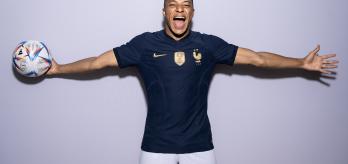Now into his second decade as a professional footballer, and with plenty more left in his shooting boots, Harry Kane is already England’s top goalscorer and the first English player to register ten goals in a single European competitive season. In 2023, he departed Tottenham Hotspur as their all-time leading goalscorer, having netted 280 goals in all competitions during his 13-season spell. His subsequent move to FC Bayern München saw him score 36 league goals in his debut season, a Bundesliga record, and a tally that he has consistently added to since.
Kane has a varied repertoire when it comes to how he scores his goals and is highly proficient using both feet and his head to score. However, what truly makes him stand out is his movement to evade opposition centre-backs in their own penalty area and during opportune transitions to attack. His consistent scanning of the pitch enhances his spatial awareness, inspiring intelligent movements that allow him to navigate the spaces around opposition centre-backs, receiving the ball in a way that eliminates their capacity to defend.
Key insights
-
Scanning the pitch to recognise where opposition defenders are in relation to their own goal and Kane’s attacking team-mates, while factoring in the space and options available to the player in possession of the ball.
-
Timing and making runs across the front of opposition centre-backs to receive the ball between them and their own goal, thereby eliminating their ability to defend the situation.
-
Using his body to get in between the opposition defender and the incoming ball, shielding them from making any contact with it and forcing them to be on the ‘wrong side’.
-
Delaying his runs when opposition defenders are recovering into their own penalty area, allowing them to defend or occupy deep space while leaving him free to receive unopposed between defensive lines or in pockets of space left vacant by unstructured or slow recovery runs.
Example 1: RECEIVING IN FRONT OF THE CENTRE-BACK
Kane’s movement to get in front of opposition centre-backs is a key feature of his centre-forward play. In this example, taken from England’s quarter-final against France during FIFA World Cup Qatar 2022™, we isolate the key components of how Kane assesses a game situation, evaluates the opportunities available, and manoeuvres into a position to receive the ball in front of the defender inside his opponent’s penalty area.
Example 2: MOVEMENT TO CREATE SPACE
Kane’s awareness and game-intelligent movements also have a significant impact on his ability to affect situations in other parts of the pitch, particularly in counter-attacking scenarios. In this example, taken from England’s World Cup 2022 victory over Senegal, we see how Kane identifies the positions of his team-mates in relation to opposition players and uses this information when processing the movements he can make which will add even more difficulty for his opponents. Kane’s actions create more problems for opposition defenders and more options for his own team-mates.
Example 3: DELAYED MOVEMENT TO RECEIVE IN SPACE LEFT BY RECOVERING CENTRE-BACKS
Kane also recognises when defenders are under pressure to prioritise defending the goal area (six-yard box) rather than focusing directly on the presence of attacking players. He understands situations that force defenders to choose to protect vulnerable space and knows how to exploit other areas inside the penalty area that may be left vacant. In this example, Kane recognises USA defenders retreating as his team-mate, Bukayo Saka (17), breaks their defensive line. Knowing the recovering defenders must prioritise the space along the goal area, Kane holds his runs and becomes available to receive, unmarked, in the space left vacant near the penalty spot.
Summary
Kane’s reading of the game allows him to create scenarios where things can happen rather than reacting to things that have happened. His commitment to scanning the pitch allows him to see how his own team-mates are affecting the decisions and positions of opposition defenders.
Based on these scenarios, Kane makes movements that create more problems for opposition defenders and, in turn, more opportunities for his own team-mates. He knows how to use his body to get between opposition defenders and the ball and when to force defenders into making decisions that compel them to leave space for him to exploit.



















